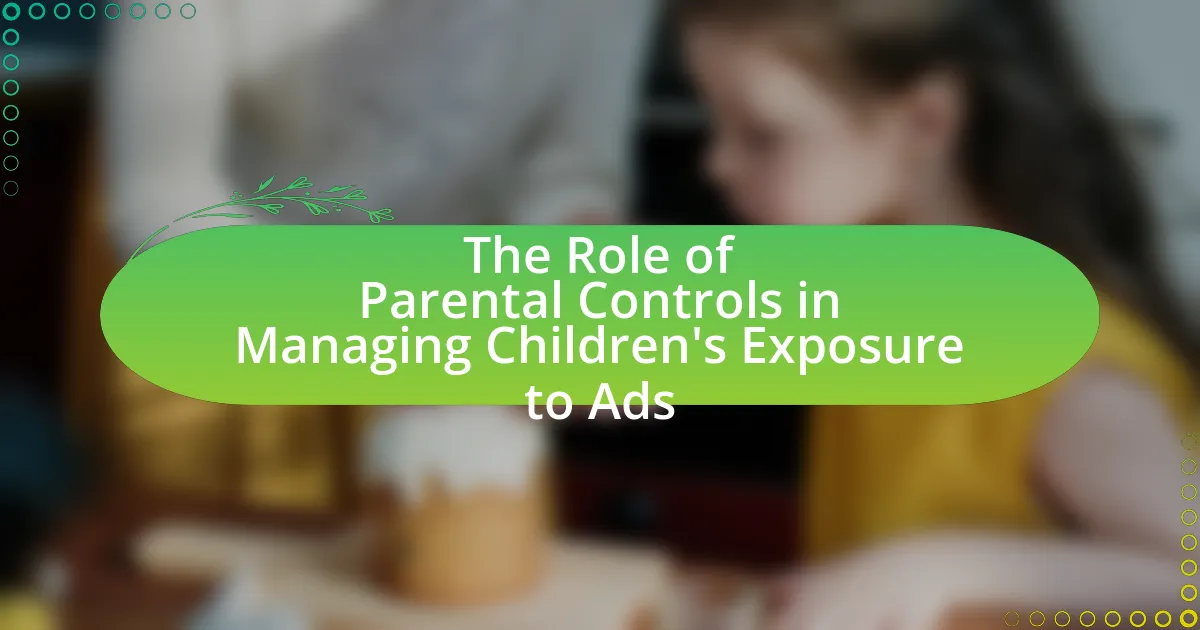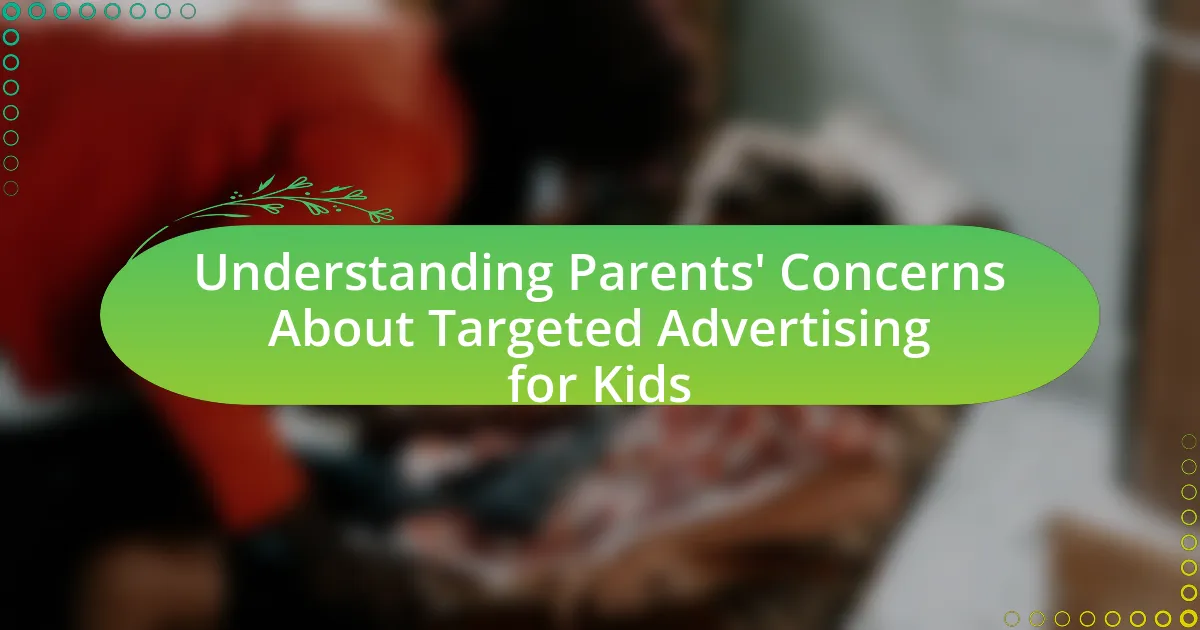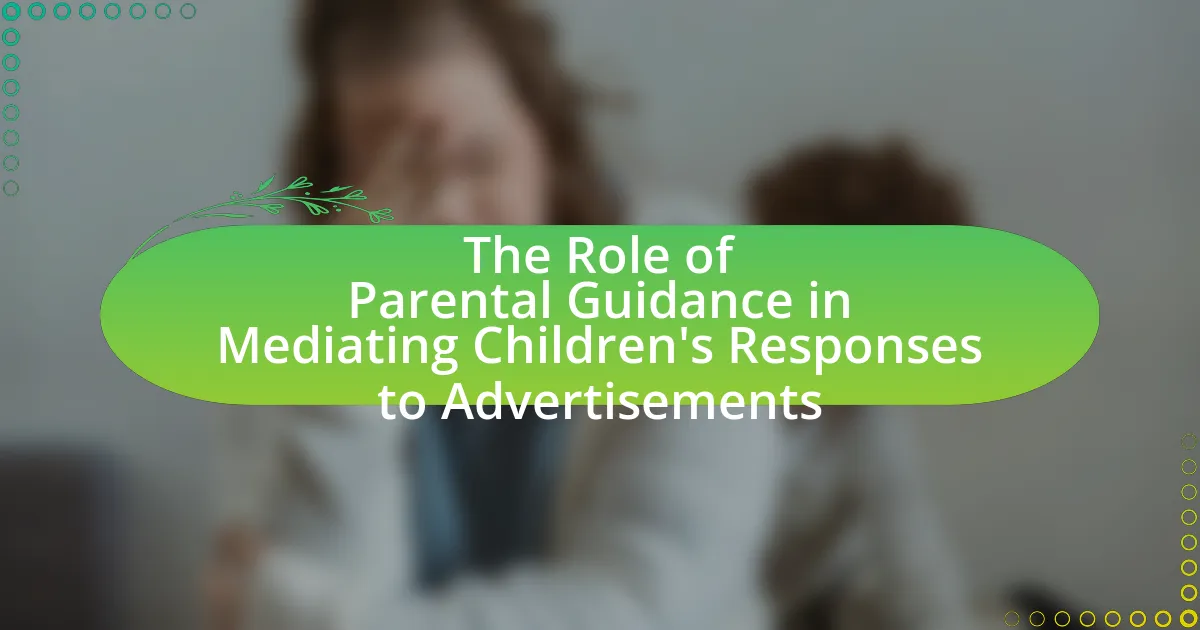The article focuses on parental strategies for discussing advertising techniques with children, emphasizing the importance of fostering critical thinking and media literacy. It outlines effective methods such as encouraging open dialogue, using real-life examples, and tailoring discussions based on children’s age and development. The article also highlights the significant impact of advertising on children’s perceptions and behaviors, the challenges parents may face in these discussions, and practical tips for creating a safe space for open dialogue. Additionally, it provides resources and materials to assist parents in educating their children about advertising.

What are Parental Strategies for Discussing Advertising Techniques with Children?
Parental strategies for discussing advertising techniques with children include fostering critical thinking, encouraging open dialogue, and using real-life examples. Parents can promote critical thinking by asking children to analyze advertisements, such as questioning the intent behind a commercial or identifying persuasive techniques used. Encouraging open dialogue allows children to express their thoughts and feelings about ads, which helps them understand the impact of advertising on their choices. Using real-life examples, such as discussing ads seen during family viewing, reinforces these concepts and makes the discussion more relatable. Research indicates that children who engage in discussions about advertising are better equipped to recognize and resist manipulative marketing tactics, enhancing their media literacy skills.
Why is it important for parents to discuss advertising techniques with their children?
It is important for parents to discuss advertising techniques with their children to enhance their critical thinking skills and media literacy. By understanding how advertisements manipulate emotions and perceptions, children can make informed decisions about their consumption choices. Research indicates that children as young as eight can recognize persuasive intent in advertising, but they often lack the skills to critically analyze these messages. Engaging in discussions about advertising helps children develop the ability to question and evaluate the information presented to them, fostering a more discerning approach to media.
What impact does advertising have on children’s perceptions and behaviors?
Advertising significantly shapes children’s perceptions and behaviors by influencing their preferences, desires, and understanding of products. Research indicates that children exposed to advertisements are more likely to develop brand loyalty and associate certain products with positive emotions. For instance, a study published in the journal “Pediatrics” found that children aged 2 to 11 are exposed to an average of 25 hours of television per week, leading to increased requests for advertised products from parents. Additionally, advertisements often promote unhealthy food choices, contributing to poor dietary habits and obesity in children, as highlighted by the World Health Organization’s report on childhood obesity. This evidence underscores the powerful role advertising plays in molding children’s consumer behavior and health-related choices.
How can early discussions shape children’s understanding of media literacy?
Early discussions can significantly shape children’s understanding of media literacy by providing them with critical thinking skills and the ability to analyze media messages. Engaging children in conversations about the intent behind advertisements and the techniques used can help them recognize persuasive strategies, such as emotional appeals and misleading information. Research indicates that children who participate in discussions about media content are better equipped to discern the credibility of sources and the motives behind various media messages, leading to more informed consumption habits. For instance, a study published in the Journal of Advertising Research found that children exposed to media literacy education demonstrated improved skills in evaluating advertisements and understanding their persuasive nature.
What are the key strategies parents can use in these discussions?
Key strategies parents can use in discussions about advertising techniques with children include fostering open communication, encouraging critical thinking, and using real-life examples. Open communication allows children to express their thoughts and questions about advertisements, creating a safe space for dialogue. Encouraging critical thinking helps children analyze the intent behind ads, promoting skills to question and evaluate the messages they encounter. Using real-life examples, such as discussing specific ads during family activities, reinforces these concepts and makes the discussions more relatable. Research indicates that children who engage in discussions about media literacy are better equipped to understand and navigate advertising messages effectively.
How can parents introduce the concept of advertising to young children?
Parents can introduce the concept of advertising to young children by discussing the purpose and techniques of advertisements in simple terms. For example, parents can explain that advertisements are designed to persuade people to buy products or services, often using colorful images and catchy slogans to grab attention. Engaging children in conversations about ads they see on television or in print can help them recognize common advertising strategies, such as emotional appeals or celebrity endorsements. Research indicates that children as young as three can begin to understand the persuasive intent of advertisements, making early discussions beneficial for developing critical thinking skills regarding media consumption.
What techniques can parents use to encourage critical thinking about ads?
Parents can encourage critical thinking about ads by engaging children in discussions about the content and intent of advertisements. This can be achieved through techniques such as asking open-ended questions about the ads they see, prompting children to analyze the persuasive techniques used, and encouraging them to identify the target audience. For example, parents can ask, “What message do you think this ad is trying to convey?” or “Who do you think this product is aimed at?” Research indicates that discussions about media literacy can enhance children’s ability to critically evaluate advertisements, leading to more informed consumer choices.
How can parents tailor their approach based on children’s age and development?
Parents can tailor their approach based on children’s age and development by adjusting the complexity of discussions and the methods used to convey information. For younger children, parents should use simple language and visual aids to explain advertising techniques, as research indicates that children under the age of 7 have difficulty understanding persuasive intent in ads. As children grow older, particularly around ages 8 to 12, parents can introduce more nuanced discussions about the motives behind advertising and encourage critical thinking by asking questions about the ads they encounter. By age 13 and beyond, adolescents can engage in deeper conversations about media literacy, including the impact of advertising on self-image and consumer behavior, as studies show that teenagers are more capable of analyzing and questioning advertising messages. This age-appropriate tailoring ensures that parents effectively communicate the complexities of advertising in a way that aligns with their children’s cognitive and emotional development.
What strategies are effective for preschool-aged children?
Effective strategies for preschool-aged children include using interactive discussions, modeling critical thinking, and employing age-appropriate language. Interactive discussions engage children by asking open-ended questions about advertisements, which helps them articulate their thoughts and understand persuasive techniques. Modeling critical thinking involves demonstrating how to analyze advertisements, such as identifying the target audience and the message being conveyed. Using age-appropriate language ensures that children comprehend the concepts being discussed, making it easier for them to grasp the nuances of advertising. Research indicates that children who are taught to critically evaluate advertisements develop better media literacy skills, which can lead to more informed decision-making as consumers.
How should discussions evolve as children grow into adolescence?
Discussions should evolve from basic explanations to more complex analyses as children grow into adolescence. Initially, parents should focus on simple concepts of advertising, such as identifying ads and understanding their purpose. As children enter adolescence, discussions should shift to critical thinking about advertising techniques, including persuasive strategies and the impact of media on consumer behavior. Research indicates that adolescents are more capable of understanding abstract concepts, allowing for deeper conversations about the ethics of advertising and its influence on societal norms. This evolution in discussions not only enhances media literacy but also empowers adolescents to make informed decisions as consumers.
What challenges might parents face when discussing advertising techniques?
Parents may face several challenges when discussing advertising techniques, including a lack of understanding of the techniques themselves and difficulty in conveying complex concepts to children. Many parents may not be fully aware of how advertising manipulates emotions and perceptions, which can hinder their ability to explain these strategies effectively. Additionally, children may have varying levels of comprehension and critical thinking skills, making it challenging for parents to tailor their discussions appropriately. Research indicates that children under the age of eight often struggle to differentiate between advertising and regular content, complicating parental efforts to instill critical viewing skills. Furthermore, parents may encounter resistance from children who are influenced by peer opinions or popular culture, making it harder to engage in meaningful conversations about advertising.
How can parents address children’s emotional responses to advertisements?
Parents can address children’s emotional responses to advertisements by engaging them in open discussions about the content and intent of the ads. This approach helps children understand the persuasive techniques used in advertising, such as emotional appeals and imagery designed to elicit specific feelings. Research indicates that children are particularly susceptible to emotional manipulation in ads, which can lead to unrealistic expectations and desires (Lindstrom, 2008). By discussing these elements, parents can foster critical thinking skills, enabling children to analyze and question the messages they encounter. Additionally, parents can encourage children to express their feelings about advertisements, validating their emotions while guiding them to differentiate between genuine needs and marketing tactics.
What are common misconceptions children have about advertising?
Children commonly believe that advertisements are entirely truthful and that the products shown will deliver exactly what is promised. This misconception arises because children often lack the critical thinking skills necessary to analyze the persuasive techniques used in advertising. Research indicates that children under the age of eight are particularly susceptible to believing that advertisements reflect reality, as they do not yet understand the intent behind marketing messages. For instance, a study published in the Journal of Consumer Research found that children are more likely to accept claims made in advertisements without skepticism, leading them to think that all advertised products are superior.
How can parents reinforce these discussions in everyday life?
Parents can reinforce discussions about advertising techniques in everyday life by integrating these conversations into daily activities, such as during shopping trips or while watching television. For instance, when parents encounter advertisements, they can pause to discuss the persuasive techniques used, such as emotional appeals or celebrity endorsements. Research indicates that children who engage in discussions about media literacy with their parents develop a better understanding of advertising strategies, leading to more critical viewing habits. By consistently addressing these topics in relatable contexts, parents help children recognize and analyze advertising messages effectively.
What role do media consumption habits play in reinforcing advertising discussions?
Media consumption habits significantly influence the reinforcement of advertising discussions by shaping children’s perceptions and understanding of marketing messages. When children frequently engage with specific media, such as television shows or online platforms, they become more exposed to targeted advertisements, which can lead to increased familiarity with advertising techniques. Research indicates that children who consume media with high advertising content are more likely to discuss and internalize the persuasive strategies used in those ads, thereby enhancing their critical thinking about marketing. For instance, a study by the American Psychological Association found that children aged 8 to 12 who watched programs with embedded advertisements demonstrated a greater ability to recognize advertising tactics compared to those with limited exposure. This suggests that consistent media consumption not only reinforces the content of advertising discussions but also equips children with the tools to analyze and critique marketing messages effectively.
How can parents use real-life examples to illustrate advertising techniques?
Parents can use real-life examples by discussing advertisements they encounter in daily life, such as commercials during television shows or ads on social media. For instance, when watching a family-friendly program, parents can pause the show to analyze a commercial, pointing out persuasive techniques like emotional appeals or celebrity endorsements. This method allows children to see how advertisers craft messages to influence consumer behavior. Research indicates that children as young as 8 can understand advertising techniques when guided by adults, making these discussions effective for developing critical thinking skills regarding media consumption.
What resources are available to assist parents in these discussions?
Resources available to assist parents in discussions about advertising techniques with children include educational websites, books, and workshops. Websites such as Common Sense Media provide guides and articles on media literacy, helping parents understand how to discuss advertising with their children effectively. Books like “The Consumer’s Guide to Advertising” by David H. Freedman offer insights into advertising strategies and how to critically analyze them. Additionally, workshops conducted by organizations like the American Psychological Association focus on teaching parents how to engage their children in conversations about media and advertising, equipping them with practical tools and strategies.
What books or materials can help parents educate their children about advertising?
Books and materials that can help parents educate their children about advertising include “The Advertising Effect: How to Change Behaviour” by Adam Ferrier, which explains the psychological principles behind advertising, and “Kid’s Guide to Advertising” by Susan M. Heim, which provides insights specifically tailored for children. Additionally, resources like the “Media Literacy Now” website offer comprehensive guides and lesson plans for teaching media literacy, including advertising analysis. These materials are effective as they provide both theoretical knowledge and practical tools for understanding advertising’s impact on consumer behavior.
How can online platforms support parents in discussing advertising techniques?
Online platforms can support parents in discussing advertising techniques by providing educational resources, interactive tools, and community forums. These platforms can offer articles, videos, and webinars that explain various advertising strategies, such as emotional appeals and persuasive messaging, which help parents understand the techniques used in marketing. Additionally, interactive tools like quizzes or games can engage both parents and children, making the learning process more effective. Community forums allow parents to share experiences and strategies, fostering a collaborative environment where they can discuss and navigate advertising techniques together. Research indicates that parental involvement in media literacy significantly enhances children’s critical thinking skills regarding advertisements, making these online resources essential for effective discussions.
What practical tips can parents implement for effective discussions?
Parents can implement active listening, open-ended questions, and a calm environment for effective discussions. Active listening involves fully concentrating on what the child is saying, which fosters trust and encourages open communication. Open-ended questions, such as “What do you think about this advertisement?” promote critical thinking and allow children to express their thoughts freely. Creating a calm environment minimizes distractions and helps children feel safe to share their opinions. Research indicates that these strategies enhance children’s understanding and engagement, making discussions more productive and meaningful.
How can parents create a safe space for open dialogue about advertising?
Parents can create a safe space for open dialogue about advertising by fostering an environment of trust and openness. This can be achieved by regularly engaging in conversations about media and advertising, encouraging children to express their thoughts and feelings without fear of judgment. Research indicates that children who feel comfortable discussing their opinions are more likely to critically analyze advertisements (Nairn & Fine, 2008). Additionally, parents can use real-life examples of advertisements to prompt discussions, helping children to identify persuasive techniques and understand the intent behind marketing messages. By actively listening and validating their children’s perspectives, parents reinforce the importance of these discussions, ultimately empowering children to navigate advertising more effectively.
What are some best practices for engaging children in conversations about ads?
To effectively engage children in conversations about ads, parents should use relatable examples and encourage critical thinking. By discussing familiar advertisements, parents can help children identify persuasive techniques such as emotional appeals or celebrity endorsements. Research indicates that children aged 8 to 12 are particularly receptive to understanding advertising strategies, making this an ideal age for such discussions. Engaging children in questions about what they see in ads fosters analytical skills and promotes media literacy, which is essential in navigating a media-saturated environment.






